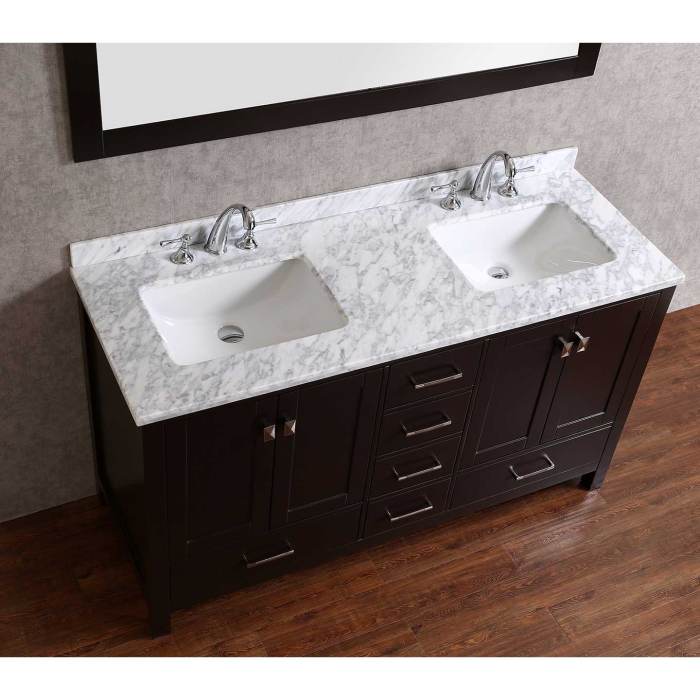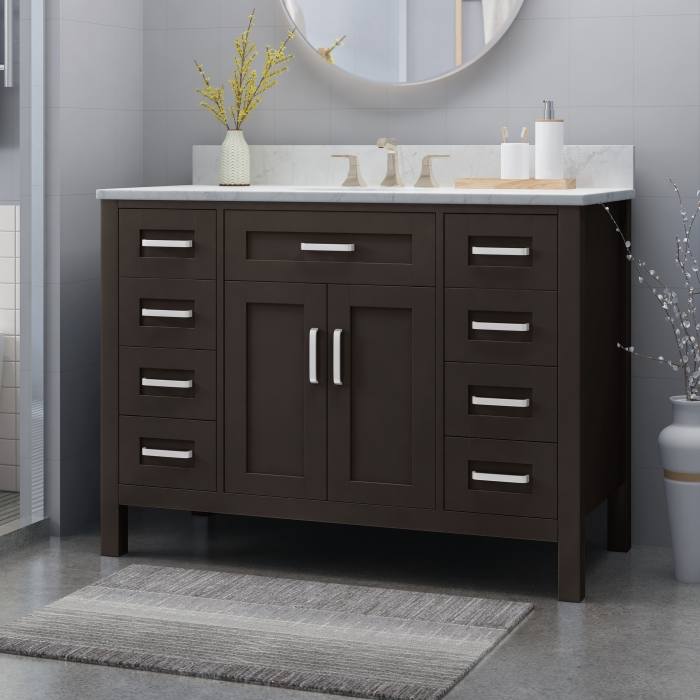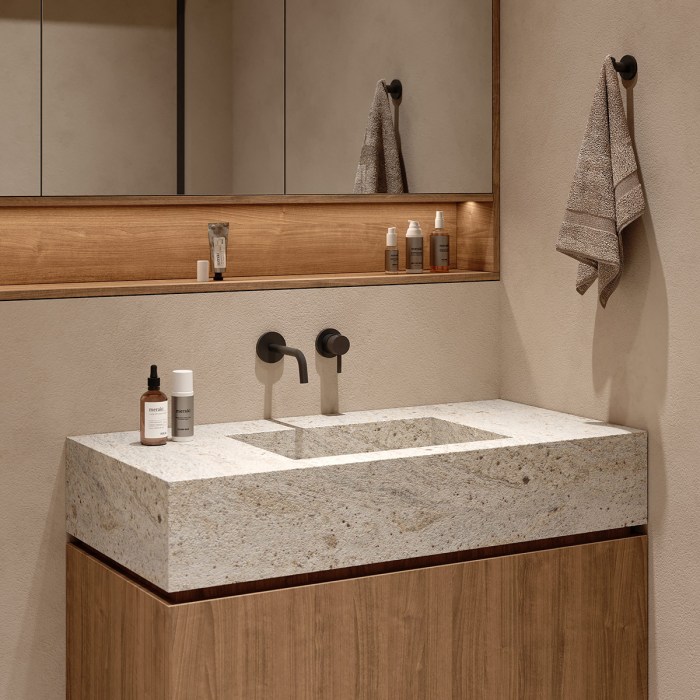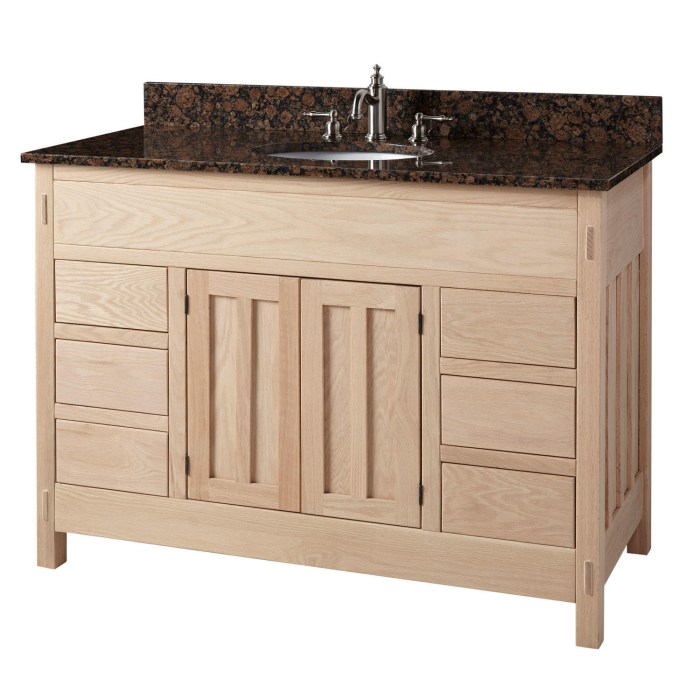Imagine transforming a raw, unfinished space into a haven of personal style. This isn’t just about adding fixtures; it’s about crafting a bathroom that reflects your unique aesthetic, starting with the heart of the room: the sink. The journey of creating an unfinished bathroom with a unique sink is a blend of artistic vision and practical considerations. We’ll explore the science of material selection, the art of layout design, and the engineering of plumbing installation, all while showcasing the stunning potential of a truly bespoke bathroom.
This guide delves into the multifaceted process, from selecting the perfect sink style—rustic, modern, or minimalist—to choosing durable and aesthetically pleasing materials for countertops and walls. We’ll examine different layout options, optimizing space and light to highlight your unique sink. We’ll also navigate the complexities of plumbing installation, offering practical advice and safety precautions for working in an unfinished environment.
Finally, we’ll provide a realistic budgeting framework and sourcing strategies to ensure your dream bathroom becomes a reality.
Unique Sink Styles for Unfinished Bathrooms

The unfinished bathroom presents a unique opportunity for creative expression. The raw, exposed elements of the space provide a blank canvas for a statement sink, transforming a functional element into a focal point. Choosing the right sink depends on the desired aesthetic and the practical considerations of durability and maintenance in an environment that may be subject to more dust and potential moisture fluctuations than a finished space.
Rustic Sink Style for Unfinished Bathrooms
A rustic sink evokes a sense of natural, unrefined beauty, perfectly complementing the unfinished aesthetic. This style often utilizes materials that showcase their inherent texture and imperfections, creating a warm and inviting atmosphere. A reclaimed wood vanity with an integrated concrete sink, for example, would exemplify this style. The concrete’s porous nature offers a unique visual texture, while the wood provides a grounding element.
Alternatively, a repurposed trough sink made from aged metal, such as galvanized steel or copper, could provide a striking industrial-rustic look. The patina developed over time would add to the overall charm and character.
Modern Sink Style for Unfinished Bathrooms
In contrast to the rustic style, a modern sink emphasizes clean lines, sleek surfaces, and minimalist design. Materials such as high-gloss porcelain, polished concrete, or even a striking resin sink could be used to create a sophisticated and contemporary look. The focus here is on simplicity and functionality. A wall-mounted sink with a minimalist faucet would enhance the space’s openness and modernity.
The use of a single, bold color, like a deep charcoal grey or a vibrant turquoise, would further accentuate the modern aesthetic, contrasting against the unfinished surroundings. Such a bold choice, however, should be carefully considered to ensure it harmonizes with the overall room design.
Minimalist Sink Style for Unfinished Bathrooms
Minimalist design prioritizes functionality and simplicity above all else. For an unfinished bathroom, a minimalist sink style would emphasize clean lines and a neutral color palette. A simple, rectangular undermount sink made from matte white porcelain or a thin, integrated stone sink would seamlessly blend into the space without overpowering it. The goal is to create a sense of calm and order, letting the unfinished elements of the bathroom provide the visual interest.
The lack of ornamentation or intricate detailing contributes to the overall sense of serenity and understated elegance.
| Style | Material | Pros | Cons |
|---|---|---|---|
| Rustic | Reclaimed wood & concrete, aged metal | Unique character, warm atmosphere, durable (depending on material), visually interesting | May require more maintenance (sealing concrete), susceptible to staining (wood), potential for uneven surfaces |
| Modern | High-gloss porcelain, polished concrete, resin | Sleek and contemporary, easy to clean, visually striking | Can be expensive, prone to showing scratches or chips (depending on material), may feel cold and impersonal in some spaces |
| Minimalist | Matte white porcelain, integrated stone | Clean and simple, easy to maintain, versatile, visually calming | Can appear stark or boring without careful consideration of surrounding elements, may not be as visually interesting as other styles |
Bathroom Layout Considerations with a Unique Sink as a Focal Point

The placement of a unique sink significantly influences the overall bathroom design and user experience. Optimizing bathroom layout requires careful consideration of ergonomics, workflow, and the aesthetic impact of the sink as a focal point. This involves strategic placement of other fixtures and thoughtful lighting design to highlight the sink’s unique features.
Layout Option 1: Sink as a Room Divider
This layout uses the unique sink as a visual and physical divider between the vanity area and the toilet/shower zone. The sink is positioned centrally, perhaps on a raised platform or peninsula, creating a clear separation. The vanity is placed on one side, offering ample counter space, and the toilet and shower are situated on the other, ensuring privacy and maintaining a comfortable flow.
Ambient lighting, supplemented by task lighting above the vanity and focused accent lighting on the sink itself, enhances the sink’s visual appeal and functionality. This arrangement works best in larger bathrooms where space allows for this division.
Layout Option 2: Sink as a Wall Feature
Here, the unique sink is mounted on a prominent wall, potentially as a vessel sink or a wall-mounted model, becoming an immediate visual focal point upon entering the bathroom. The vanity is placed underneath or adjacent to the sink, maintaining a sense of visual unity. The toilet and shower are positioned in a separate zone, possibly behind a partial wall or cleverly concealed by a room divider, to minimize visual disruption.
Uplighting on the wall behind the sink and soft, diffused lighting from above create a dramatic effect, highlighting the sink’s texture and form. This layout suits bathrooms of various sizes, offering flexibility in fixture placement.
Layout Option 3: Sink as an Island Element
In spacious bathrooms, the unique sink can be the centerpiece of an island unit. This arrangement offers excellent accessibility from multiple sides and creates a luxurious feel. The island can incorporate storage, additional counter space, and even seating. The toilet and shower are placed along the surrounding walls, maintaining a comfortable distance from the island. Recessed lighting beneath the island, combined with pendant lights above and subtle wall-washing lighting, provides even illumination, emphasizing the sink’s three-dimensional qualities.
This design is ideal for larger bathrooms where space allows for a statement piece.
Visual Representation of Layout Option 1: Sink as a Room Divider
Imagine a rectangular bathroom (approximately 8ft x 10ft). A striking, free-standing oval sink made of polished concrete, featuring a unique integrated drain, sits centrally, acting as a room divider. This sink rests on a slightly raised platform, finished with the same polished concrete, extending approximately 3ft in length. To the left, a sleek, minimalist vanity with a matte black finish and ample storage sits flush against the wall.
Above the vanity, three slim, linear LED lights provide focused task lighting. To the right, a frameless glass shower enclosure is discreetly tucked into a corner, with a wall-mounted rain shower head. The toilet is positioned opposite the shower, against the wall, maintaining a comfortable distance from the sink. The overall lighting scheme is warm and inviting, with recessed lighting in the ceiling providing general illumination.
Accent lighting, using small, adjustable spotlights, is strategically placed to highlight the curves and texture of the concrete sink. The walls are painted a soft, neutral gray, allowing the unique sink and its surroundings to stand out. The flooring is a large-format porcelain tile in a light beige, providing a clean and modern aesthetic.
Material Choices for an Unfinished Bathroom Featuring a Unique Sink
The selection of materials for an unfinished bathroom, particularly when incorporating a unique sink as a focal point, significantly impacts the overall aesthetic, durability, and maintenance. The chosen materials must complement the sink’s material (concrete, reclaimed wood, or copper) while withstanding the unique challenges of a bathroom environment, such as moisture and temperature fluctuations. Careful consideration of these factors is crucial for achieving a harmonious and long-lasting design.The inherent properties of each material, including its porosity, resistance to water damage, and ease of cleaning, dictate its suitability for this demanding space.
Furthermore, the chosen materials should reflect the desired design style, whether rustic, modern, or minimalist.
Material Properties and Design Suitability
The following materials offer diverse aesthetic and functional qualities, making them suitable candidates for an unfinished bathroom with a unique sink. Each material’s performance varies based on factors such as quality, application, and ongoing maintenance. For example, a poorly sealed natural stone countertop can be more prone to staining than a well-sealed one.
- Natural Stone (e.g., marble, slate, granite): Natural stone offers a timeless elegance and comes in a wide array of colors and textures. Marble, with its luxurious veining, is ideal for a more classic or traditional aesthetic. Slate, known for its durability and matte finish, suits rustic or modern styles. Granite, with its high resistance to staining and scratching, is a versatile option for any design.
Maintenance involves regular sealing to prevent water damage and staining. Cost varies significantly depending on the type of stone and its origin. It is generally considered a more expensive option. Suitability: Rustic, Modern, Minimalist (depending on the stone type and finish).
- Concrete: Concrete countertops and walls create a strong, industrial aesthetic, perfectly complementing a concrete, copper, or reclaimed wood sink. Concrete’s inherent durability and resistance to moisture make it a practical choice for a bathroom. Proper sealing is essential to prevent staining and water damage. The material is relatively inexpensive compared to natural stone. Maintenance involves occasional sealing and cleaning with a pH-neutral cleaner.
Suitability: Modern, Industrial.
- Ceramic Tile: Ceramic tile offers exceptional water resistance and durability, making it a classic choice for bathrooms. Its versatility allows for a wide range of colors, patterns, and textures, catering to various design styles. Grout lines require regular cleaning to prevent mold and mildew growth. Ceramic tile is a cost-effective option compared to natural stone or concrete countertops, with the cost varying based on tile type and installation.
Suitability: Rustic, Modern, Minimalist.
- Reclaimed Wood (with proper treatment): Reclaimed wood, particularly when treated with water-resistant sealants, can create a rustic and unique bathroom aesthetic. The character and texture of reclaimed wood complement a reclaimed wood or copper sink beautifully. However, proper sealing and regular maintenance are crucial to prevent water damage and rot. It is essential to select wood species naturally resistant to moisture.
The cost varies depending on the type of wood and its condition. Suitability: Rustic.
- Porcelain: Porcelain offers a sleek and modern look, similar to ceramic tile but with higher density and water resistance. Its non-porous nature makes it extremely durable and easy to clean. It’s available in a variety of colors and finishes, adapting to different design styles. Maintenance is minimal. Porcelain is generally more expensive than ceramic tile.
Suitability: Modern, Minimalist.
Plumbing and Installation Aspects of a Unique Sink in an Unfinished Bathroom

Installing a unique sink in an unfinished bathroom presents both advantages and challenges. The unfinished state allows for easier access to plumbing and electrical, simplifying some aspects of installation. However, the lack of finished walls and flooring requires careful planning and execution to avoid damage and ensure proper functionality. Understanding the specific plumbing requirements for different sink types and following safe installation practices are crucial for a successful outcome.
Plumbing Requirements for Vessel, Undermount, and Console Sinks
The plumbing requirements vary significantly depending on the sink type. Vessel sinks, sitting atop the countertop, require a tall, exposed drainpipe and often a dedicated drain assembly. Undermount sinks, installed beneath the countertop, necessitate precise cutout and require the drainpipe to be integrated within the cabinet structure. Console sinks, with integrated countertops and supports, typically involve connecting to existing plumbing lines under the vanity.
Pipe sizing is determined by the sink’s drainage capacity; larger sinks generally necessitate larger-diameter pipes to prevent clogging. Local plumbing codes dictate minimum pipe sizes and slope requirements for proper drainage, typically a minimum gradient of 1/4 inch per foot. Failure to adhere to these codes can lead to slow drainage or even backups. For example, a vessel sink with a large basin might require a 1 1/2 inch drainpipe, while a smaller undermount sink might suffice with a 1 1/4 inch pipe.
Proper venting is also essential to prevent sewer gases from entering the bathroom.
Installation Steps for Unique Sinks in an Unfinished Bathroom
The installation process, while generally similar across sink types, differs in specific details. Before beginning, always turn off the water supply to the area. For vessel sinks, the process involves positioning the sink on the countertop, marking the drain hole location, and then cutting the hole using a specialized hole saw. The drain assembly is then attached, followed by connecting the drainpipe to the existing plumbing.
Undermount sinks require a precise cutout in the countertop, ensuring a snug fit. The sink is then secured from below, and the drainpipe is connected. Console sinks typically require attaching the pre-assembled unit to the wall, ensuring proper leveling and stability before connecting the plumbing. In an unfinished bathroom, the ease of accessing the plumbing lines beneath the floor significantly simplifies these connections.
However, careful planning and precise measurements are crucial to ensure proper alignment and prevent potential leaks. For instance, incorrectly positioned drain holes can lead to improper drainage or require extensive rework.
Necessary Tools and Safety Precautions
Installing a unique sink requires specific tools, including a level, measuring tape, hole saw (for vessel sinks), plumber’s putty, adjustable wrenches, pipe cutters, and a basin wrench. Safety precautions are paramount. Always wear safety glasses to protect your eyes from debris and sharp objects. Use gloves to prevent skin irritation from chemicals and rough surfaces. When working with plumbing, be mindful of potential water leaks and have towels or rags ready to absorb any spills.
Furthermore, always ensure the water supply is turned off before starting any plumbing work to prevent flooding. Proper ventilation is essential when working with solvents or adhesives. Finally, consult a professional plumber if you encounter any unexpected challenges or are unsure about any aspect of the installation process. This ensures compliance with building codes and minimizes the risk of costly mistakes.
Budgeting and Sourcing for a Unique Sink and Unfinished Bathroom Renovation
Renovating an unfinished bathroom, especially one featuring a unique sink, requires careful budgeting and strategic sourcing to ensure a successful and cost-effective project. Understanding the various cost components and exploring different avenues for acquiring materials are crucial steps in managing the overall expense. This section will Artikel a sample budget, explore various sourcing options for unique sinks, and demonstrate a method for calculating total project costs, including a contingency for unforeseen issues.
Sample Budget Breakdown for an Unfinished Bathroom Renovation
A realistic budget should encompass all aspects of the renovation, from materials to labor. The following breakdown provides a general estimate; actual costs will vary depending on location, materials chosen, and the complexity of the installation. This example assumes a moderately sized bathroom.
| Category | Estimated Cost (USD) |
|---|---|
| Unique Sink | $500 – $3000 (depending on material and design) |
| Vanity/Cabinetry | $500 – $2000 |
| Toilet | $100 – $500 |
| Shower/Tub (if applicable) | $500 – $3000 |
| Flooring (tile, vinyl, etc.) | $500 – $1500 |
| Wall Finishes (paint, tile, etc.) | $500 – $1500 |
| Plumbing Fixtures & Materials | $300 – $1000 |
| Lighting | $100 – $500 |
| Labor (plumbing, installation, etc.) | $2000 – $5000 |
| Permits | $100 – $500 |
| Contingency (10-20% of total cost) | $500 – $2500 |
Sources for Purchasing Unique Sinks
Finding a unique sink requires exploring diverse avenues. Three primary sources offer distinct advantages and disadvantages:
The selection of a sourcing method depends largely on budget, desired aesthetic, and the level of customization required. A careful evaluation of these factors will lead to an informed decision.
- Online Retailers: Websites like Etsy, Wayfair, and specialized bathroom retailers offer a wide selection of unique sinks from various manufacturers and artisans. Advantages include convenience and a broad range of choices. Disadvantages include potential shipping costs, longer lead times, and the inability to physically inspect the sink before purchase. The risk of damage during shipping is also a factor to consider.
- Local Artisans: Commissioning a custom sink from a local artisan allows for complete personalization and often results in a truly one-of-a-kind piece. Advantages include high quality, unique design, and the opportunity to work directly with the creator. Disadvantages include higher costs, longer lead times, and the potential for less predictable production timelines.
- Salvage Yards and Antique Shops: These sources offer vintage and reclaimed sinks, often at significantly lower prices than new ones. Advantages include sustainability, unique character, and affordability. Disadvantages include limited availability, potential need for repairs or restoration, and the possibility of finding sinks with minor imperfections or damage. The condition of plumbing connections needs thorough inspection before purchase.
Calculating Total Renovation Cost
To calculate the total cost, sum the estimated costs from each category in the budget breakdown. Then, add a contingency of 10-20% to account for unforeseen expenses, such as material price increases, unexpected repairs, or additional labor. For example, if the estimated cost is $8000, a 15% contingency would add $1200, bringing the total projected cost to $
9200. This formula is represented as
Total Project Cost = Sum of Estimated Costs + (Contingency Percentage
Sum of Estimated Costs)
Final Thoughts

Creating an unfinished bathroom with a unique sink is a rewarding endeavor that blends creativity, practicality, and a deep understanding of materials and construction. By carefully considering sink style, layout, materials, plumbing, and budget, you can transform a blank canvas into a personalized sanctuary. Remember, the key is to balance your aesthetic vision with the realities of construction, resulting in a space that is both beautiful and functional, a testament to your unique design sensibilities and the power of thoughtful planning.
Essential Questionnaire
What are some common mistakes to avoid when installing a unique sink?
Common mistakes include improper sealing around the sink, neglecting to account for sufficient drainage slope, and failing to properly secure the sink to the countertop or vanity. Improper pipe sizing can also lead to drainage issues.
How can I ensure my unique sink complements the overall bathroom design?
Consider the overall style (rustic, modern, minimalist) and color palette of your bathroom. Choose a sink material and style that harmonizes with these elements. Pay attention to the scale of the sink relative to the size of the bathroom to avoid overwhelming or understating the space.
What are some eco-friendly material options for an unfinished bathroom?
Sustainable choices include reclaimed wood for vanities and shelving, recycled glass countertops, and low-VOC paints. Consider using locally sourced materials to minimize transportation emissions.
Can I install a unique sink myself, or should I hire a professional?
While some DIY-savvy individuals might attempt installation, complex plumbing work is best left to licensed professionals. Improper installation can lead to leaks and other costly problems.
How much should I budget for unexpected costs during renovation?
It’s recommended to allocate 10-20% of your total budget for unforeseen expenses. This accounts for potential material price increases, unexpected plumbing issues, or changes in design.
